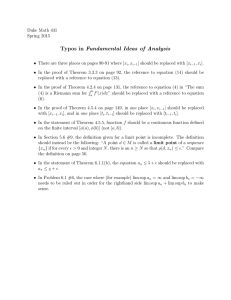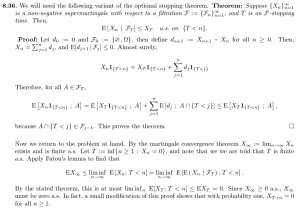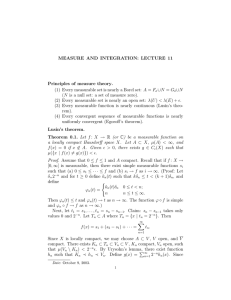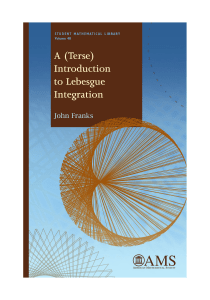MEASURE AND INTEGRATION: LECTURE 5
advertisement
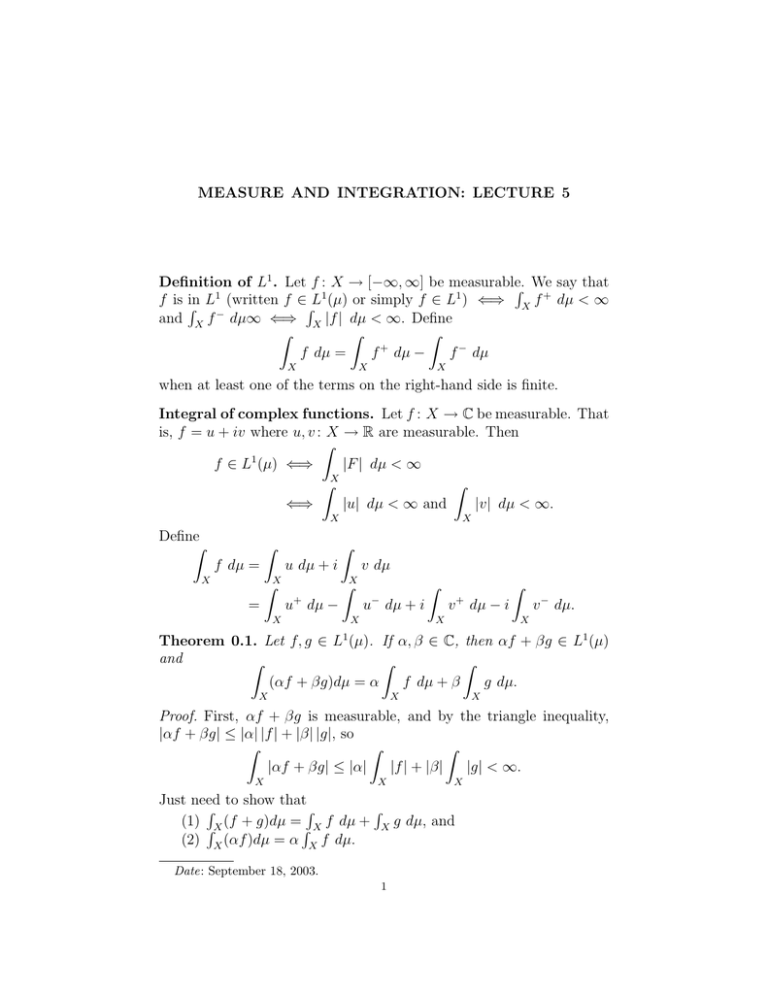
MEASURE AND INTEGRATION: LECTURE 5
Definition of L1 . Let f : X → [−∞, ∞] be measurable.
� We say that
f is �in L1 (written f ∈�L1 (µ) or simply f ∈ L1 ) ⇐⇒ X f + dµ < ∞
and X f − dµ∞ ⇐⇒ X |f | dµ < ∞. Define
�
�
�
+
f dµ =
f dµ −
f − dµ
X
X
X
when at least one of the terms on the right­hand side is finite.
Integral of complex functions. Let f : X → C be measurable. That
is, f = u + iv where u, v : X →
R are measurable. Then
�
1
f ∈ L (µ) ⇐⇒
|F | dµ < ∞
X
�
�
⇐⇒
|u| dµ < ∞ and
|v | dµ < ∞.
X
Define
�
�
f dµ =
X
�
u dµ + i
X
v dµ
X
�
X
+
�
u dµ −
=
�
−
v dµ − i
u dµ + i
X
X
�
+
X
v − dµ.
X
1
Theorem 0.1. Let f, g ∈ L (µ). If α, β ∈ C, then αf + βg ∈ L1 (µ)
and
�
�
�
(αf + βg)dµ = α
f dµ + β
g dµ.
X
X
X
Proof. First, αf + βg is measurable, and by the triangle inequality,
|αf + βg| ≤ |α| |f | + |β| |g |, so
�
�
�
|αf + βg| ≤ |α|
|f | + |β|
|g | < ∞.
X
X
X
Just need to show that
�
�
�
(1) �X (f + g)dµ =� X f dµ + X g dµ, and
(2) X (αf )dµ = α X f dµ.
Date: September 18, 2003.
1
2
MEASURE AND INTEGRATION: LECTURE 5
For (1), assume f, g real; the complex case follows from the real case.
Let h = f + g. Then h+ − h− = f + − f − + g + − g − , so h+ + f − + g − =
f + + g + + h− . Since the integral is linear for non­negative functions,
�
�
�
�
�
�
+
−
−
+
+
h + f + g = f + g + h− ⇒
�
�
�
�
�
�
+
−
+
−
+
h − h = f − f + g − g−.
�
�
�
Thus, f + g = f + g.
For (2), let α = a + bi for a, b ∈ R. Then
�
�
�
αf = (a + bi)(u + iv) = au + aiv + biu − bv
�
= (au − bv + i(av + bu)
�
�
= (au − bv) + i (av + bu).
Also,
��
�
�
�
(a + bi)
(u + iv) = (a + bi)
u+i v
�
�
�
�
= a u + bi u + ai v − b v.
�
�
So, just need to show that au = a u. If a = 0, then both sides
vanish. If a > 0, then
�
�
�
+
(au) = (au) − (au)−
�
�
+
= a · u − a · u−
�
�
�
+
−
= a u − a u = a u.
If a < 0, then
�
�
�
(au)−
�
�
−
= (−a) · u − (−a) · u+
�
�
−
= −a u − (−a) u+
��
�
�
�
+
−
=a
u − u
= a u.
au =
+
(au) −
MEASURE AND INTEGRATION: LECTURE 5
3
�
Theorem 0.2. If f ∈ L1 (µ), then
��
� �
�
�
� f dµ� ≤
|f | dµ.
�
�
X
X
Proof. For some θ ∈ [0, 2π),
��
�
�
�
�
�
f dµ = �
f dµ��
eiθ .
X
X
Hence,
��
�
�
�
�
�
� f dµ� = e−iθ
f dµ =
(e−iθ f )dµ
�
�
X
X
X
��
�
−iθ
= Re
e f dµ
X
�
=
Re(e−iθ f )dµ
�X
�
� −iθ �
�
�
≤
e f dµ =
|f | dµ.
X
X
�
Dominated convergence.
Theorem 0.3. Let fn : X → C be a sequence of measurable functions,
and assume that f (x) = limn→∞ fn (x) (that is, the sequence fn con­
verges pointwise). If there exists g ∈ L1 (µ) such that |fn (x)| ≤ g(x)
for all n and for all x ∈ X, then f ∈ L1 (µ) and
�
�
�
lim
|fn − f | dµ = 0, so lim
fn dµ =
f dµ.
n→∞
n→∞
X
X
X
Proof. Since |fn (x)| ≤ g(x) for all�n, the limit
� f has the property 1that
|f | ≤ |g(x)|. This means that |f | ≤ |g | < ∞,
so f ∈ L (µ).
Next, |fn − f | ≤ |fn | + |f | ≤ 2g, which means that 2g − |fn − f | ≥ 0.
Applying Fatou’s lemma,
�
�
2g dµ ≤ lim inf (2g −
|fn − f |)dµ
X
X
�
�
=
2g dµ + lim inf
− |fn − f | dµ
X
�
�X
=
2g dµ − lim sup
|fn − f | dµ.
X
X
4
MEASURE AND INTEGRATION: LECTURE 5
Since
�
X
2g < ∞, it can be cancelled from both sides. Thus,
�
lim sup
|fn − f | dµ ≤ 0,
X
and so
�
|fn − f | dµ = 0.
lim
X
From the previous theorem,
��
� �
�
�
� (fn − f )dµ� ≤
|fn − f | dµ
�
�
X
X
��
� �
�
�
�
⇒ ��
fn dµ −
f dµ�� ≤
|fn − f | dµ → 0
X
X
X
�
�
⇒ fn dµ →
f dµ.
X
X
�
Sets of measure zero. Let (X, M, µ) be a measure space and E ∈
M. A set E has measure zero if and only if µ(E) = 0. If f, g : X → C,
then f = g almost everywhere (a.e.) if N = {x | f (x) = g(x)} has
measure zero. Define an equivalence relation f ∼ g if f = g a.e.
�
�
Proposition 0.4. If f ∼ g, then, for all E ∈ M, E f dµ = E g dµ.
Proof. Write E as disjoint union E = (E \ N ) ∪ (E ∩ N ). Then, since
f = g away from N , and since N has measure zero,
�
�
�
f dµ =
f dµ +
f dµ
E
E\N
E∩N
�
�
=
g dµ + 0 =
g dµ.
E\N
E
�
Completion of a σ­algebra.
Theorem 0.5. Let (X, M, µ) be a measure space. Let
M∗ = {E ⊂ X | ∃A, B ∈ M : A ⊂ E ⊂ B & µ(B \ A) = 0}.
Now define µ(E) = µ(A) for all E ∈ M∗ . Then M∗ is a σ­algebra and
this definition of µ is a measure.
The measure space (X, M∗ , µ) is a called the completion of the mea­
sure space (X, M, µ). A measure space is complete if it is equal to its
completion.
Note.
If f is only defined a.e. (say, except for a�set N of measure
zero), then we can define f (x) = 0 for all x ∈ N . ⇒ f is well defined.
MEASURE AND INTEGRATION: LECTURE 5
5
Theorem
(a) Let f : X → [0, ∞] be measurable, E ∈ M, and
� 0.6.
f
dµ
=
0.
Then �f = 0 a.e. on E.
E
1
(b) Let f ∈ L (µ) and E f dµ = 0 for every E ∈ M. Then f = 0
a.e. on X.
Proof.
(a) Let An = {x ∈ E | f (x) > 1/n}. Then
�
�
�
1
f dµ ≥
f dµ ≥
1/n dµ = µ(An ),
n
E
An
An
which implies that µ(An )�
= 0. But {x | f (x) > 0} = ∪∞
i=1 An
and µ({x | f (x) > 0}) ≤ ∞
µ
(A
)
=
0.
n
i=1
�
(b) Let
f
=
u
+
iv.
Choose
E
=
{
x
|
u
(
x
)
≥
0
}
.
Then
f =
E
�
� +
� +
+
u + i E v ⇒ E u = 0 and by (a), u = 0 a.e.
E
�
�∞
Theorem 0.7. Let Ek ∈ M such that k=1 µ(Ek ) < ∞. Then almost
every x ∈ X lie in at most finitely many Ek .
Proof. Let
�A = {x ∈ X | x ∈ Ek for infinitely many k}. NTS µ(A) = 0.
Let g = ∞
i=1 χEk .
Then x ∈ A ⇐⇒ g(x) = ∞. We have
�
∞ �
∞
�
�
g dµ =
χEk dµ =
µ(Ek ) < ∞.
X
i=1
1
X
i=1
In other words, g ∈ L (µ) and thus g(x) < ∞ a.e.
�

